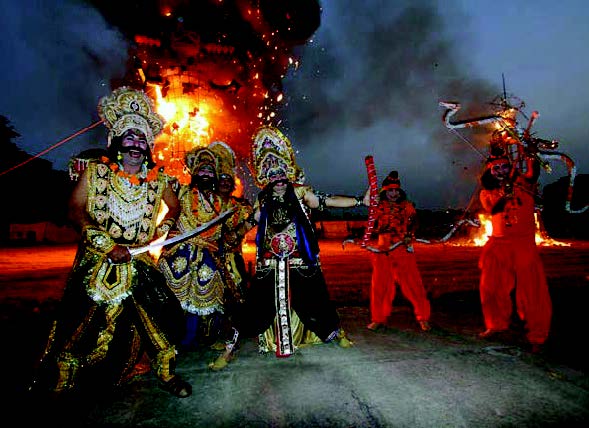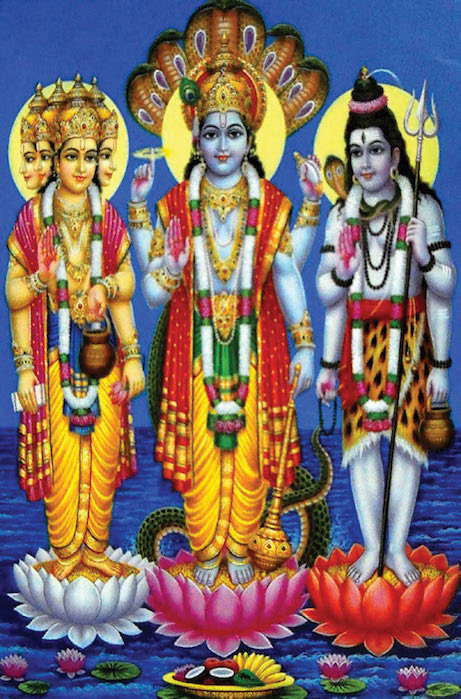
Every year during the lunar month of Ashwin or Kartik (September-October), Hindus observe ten days of ceremonies, rituals, fasts and feasts in honor of the supreme mother goddess. It begins with the fast of “Navaratri”, and ends with the festivities of “Dussehra” and “Vijayadashami.”
Goddess Durga
This festival is devoted solely to the Mother Goddess — known variously as Durga, Bhavani, Amba, Chandika, Gauri, Parvati, Mahishasuramardini — and her other manifestations. The name “Durga” means “inaccessible”, and she is the personification of the active side of the divine “shakti” energy of Lord Shiva . In fact, she represents the furious powers of all the male gods, and is the ferocious protector of the righteous, and destroyer of the evil. Durga is usually portrayed as riding a lion, and carrying weapons in her many arms.
A Universal Festival
All Hindus celebrate this festival at the same time in different ways in different parts of India as well as around the world. In the northern part of the country, the first nine days of this festival, called Navaratri, is commonly observed as a time for rigorous fast, followed by celebrations on the tenth day. In western India, throughout the nine days, both men and women participate in a special kind of dance around an object of worship. In the south, Dusshera or the tenth day is celebrated with a lot of fanfare. In the east, people go crazy over Durga Puja, from the seventh till the tenth day of this annual festival. Although, the universal nature of the festival is often found to transcend regional influences and local culture, the Garba Dance of Gujarat, Ramlila of Varanasi, Dusshera of Mysore, and Durga Puja of Bengal need special mention.
Durga Puja
In eastern India, especially in Bengal, the Durga Puja is the principal festival during Navaratri. It is celebrated with gaiety and devotion through public ceremonies of “Sarbojanin Puja” or community worship. Huge decorative temporary structures called “pandals” are constructed to house these grand prayer services, followed by mass feeding, and cultural functions. The earthen icons of Goddess Durga, accompanied by those of Lakshmi , Saraswati , Ganesha and Kartikya, are taken out on the tenth day in a triumphal procession to the nearby river, where they are ceremonially immersed. Bengali ladies give an emotioncharged send-off to Durga amidst ululations and drumbeats. This marks the end of the goddess’ brief visit to the earth. As Durga leaves for Mount Kailash, the abode of her husband Shiva, it’s time for “Bijoya” or Vijayadashami, when people visit each other’s homes, hug each other and exchange sweets.
The Garba & Dandia Dance
People in western India, especially in Gujarat, spend the nine nights of Navaratri ( nava = nine; ratri = night) in song, dance and merriment. Garba is a graceful form of dance, wherein women dressed in exquisitely embroidered choli, ghagra and bandhani dupattas , dance gracefully in circles around a pot containing a lamp. The word “Garba” or “Garbha” means “womb”, and in this context the lamp in the pot, symbolically represent life within a womb. Besides the Garba is the “Dandia” dance, in which men and women participate in pairs with small, decorated bamboo sticks called dandias in their hands. At the end of these dandias are tied tiny bells called ghungroos that make a jingling sound when the sticks hit one another. The dance has a complex rhythm. The dancers begin with a slow tempo, and go into frenzied movements, in such a manner that each person in a circle not only performs a solo dance with his own sticks, but also strikes his partner’s dandias in style!
Dussehra, as the name suggests occurs on the “tenth” day following the Navratri. It is a festival to celebrate the triumph of good over evil, and marks the defeat and death of the demon king Ravana in the epic Ramayana . Huge effigies of Ravana are burnt amidst the bangs and booms of firecrackers. In northern India, especially in Varanasi, Dusshera overlaps with “Ramlila” or “Rama Drama” – traditional plays in which scenes from the epic saga of the mythical Rama-Ravana strife are enacted by professional troupes. The Dussehra celebration of Mysore in southern India is a veritable extravaganza! Chamundi, a form of Durga, is the family deity of the Maharaja of Mysore. It’s a wonderful scene to watch the grand procession of elephants, horses and courtiers wending a circuitous way to the hilltop temple of Goddess Chamundi!






Be the first to comment